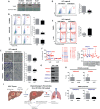Chemotherapy-Enriched THBS2-Deficient Cancer Stem Cells Drive Hepatocarcinogenesis through Matrix Softness Induced Histone H3 Modifications
- PMID: 33717837
- PMCID: PMC7927606
- DOI: 10.1002/advs.202002483
Chemotherapy-Enriched THBS2-Deficient Cancer Stem Cells Drive Hepatocarcinogenesis through Matrix Softness Induced Histone H3 Modifications
Abstract
The physical microenvironment is a critical mediator of tumor behavior. However, detailed biological and mechanistic insight is lacking. The present study reveals the role of chemotherapy-enriched CD133+ liver cancer stem cells (CSCs) with THBS2 deficiency. This subpopulation of cells contributes to a more aggressive cancer and functional stemness phenotype in hepatocellular carcinoma (HCC) by remodeling the extracellular matrix (ECM) through the regulation of matrix metalloproteinase (MMP) activity, collagen degradation, and matrix stiffness. The local soft spots created by these liver CSCs can enhance stemness and drug resistance and provide a route of escape to facilitate HCC metastasis. Interestingly, a positive feed-forward loop is identified where a local soft spot microenvironment in the HCC tumor is enriched with CD133 expressing cells that secrete markedly less ECM-modifying THBS2 upon histone H3 modification at its promoter region, allowing the maintenance of a localized soft spot matrix. Clinically, THBS2 deficiency is also correlated with low HCC survival, where high levels of CSCs with low THBS2 expression in HCC are associated with decreased collagen fiber deposits and an invasive tumor front. The findings have implications for the treatment of cancer stemness and for the prevention of tumor outgrowth through disseminated tumor cells.
Keywords: CD133; THBS2; cancer stemness; hepatocellular carcinomas; histone modifications; matrix stiffness; mechanoepigenetics; metastasis.
© 2021 The Authors. Advanced Science published by Wiley‐VCH GmbH.
Conflict of interest statement
The authors declare no conflict of interest.
Figures






Similar articles
-
Matrix stiffness-mediated effects on stemness characteristics occurring in HCC cells.Oncotarget. 2016 May 31;7(22):32221-31. doi: 10.18632/oncotarget.8515. Oncotarget. 2016. PMID: 27050147 Free PMC article.
-
A pivotal role of Krüppel-like factor 5 in regulation of cancer stem-like cells in hepatocellular carcinoma.Cancer Biol Ther. 2015;16(10):1453-61. doi: 10.1080/15384047.2015.1070992. Epub 2015 Jul 15. Cancer Biol Ther. 2015. PMID: 26176896 Free PMC article.
-
Lipopolysaccharide supports maintaining the stemness of CD133(+) hepatoma cells through activation of the NF-κB/HIF-1α pathway.Cancer Lett. 2016 Aug 10;378(2):131-41. doi: 10.1016/j.canlet.2016.05.014. Epub 2016 May 18. Cancer Lett. 2016. PMID: 27208741
-
Cancer Stem Cells in Hepatocellular Carcinoma: Intrinsic and Extrinsic Molecular Mechanisms in Stemness Regulation.Int J Mol Sci. 2022 Oct 14;23(20):12327. doi: 10.3390/ijms232012327. Int J Mol Sci. 2022. PMID: 36293184 Free PMC article. Review.
-
Biology and clinical implications of CD133(+) liver cancer stem cells.Exp Cell Res. 2013 Jan 15;319(2):126-32. doi: 10.1016/j.yexcr.2012.09.007. Epub 2012 Sep 19. Exp Cell Res. 2013. PMID: 22999864 Review.
Cited by
-
An SCD1-dependent mechanoresponsive pathway promotes HCC invasion and metastasis through lipid metabolic reprogramming.Mol Ther. 2022 Jul 6;30(7):2554-2567. doi: 10.1016/j.ymthe.2022.03.015. Epub 2022 Mar 28. Mol Ther. 2022. PMID: 35358687 Free PMC article.
-
Phenotypic Heterogeneity, Bidirectionality, Universal Cues, Plasticity, Mechanics, and the Tumor Microenvironment Drive Cancer Metastasis.Biomolecules. 2024 Feb 3;14(2):184. doi: 10.3390/biom14020184. Biomolecules. 2024. PMID: 38397421 Free PMC article. Review.
-
Five EMT-related genes signature predicts overall survival and immune environment in microsatellite instability-high gastric cancer.Cancer Med. 2023 Jan;12(2):2075-2088. doi: 10.1002/cam4.4975. Epub 2022 Jul 4. Cancer Med. 2023. PMID: 35789544 Free PMC article.
-
Targeting the mechano-microenvironment and liver cancer stem cells: a promising therapeutic strategy for liver cancer.Cancer Biol Med. 2023 Nov 24;20(11):816-29. doi: 10.20892/j.issn.2095-3941.2023.0229. Cancer Biol Med. 2023. PMID: 38009775 Free PMC article. Review.
-
Extracellular matrix remodeling in tumor progression and immune escape: from mechanisms to treatments.Mol Cancer. 2023 Mar 11;22(1):48. doi: 10.1186/s12943-023-01744-8. Mol Cancer. 2023. PMID: 36906534 Free PMC article. Review.
References
LinkOut - more resources
Full Text Sources
Other Literature Sources
Research Materials
Miscellaneous
